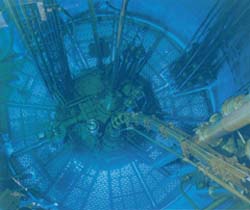Nucleus Is Larger than Life

A typical atomic nucleus is just m across, but sometimes its influence can extend far beyond its size. Using a beam of ultracold neutrons to probe the gadolinium nucleus, a team has measured the largest nuclear “cross section” ever observed: The nucleus swallowed up any neutrons approaching within a distance 10,000 times its diameter. The dramatic effect, reported in the 13 December PRL had been predicted theoretically for slow neutrons interacting with gadolinium but had not been demonstrated before. The team also found evidence for deviations from theory.
A slow-moving neutron spends more time near a target nucleus than a fast-moving neutron, so it is more likely to interact. That makes the cross section–the nucleus’s effective “target area”–larger for slower neutrons. In gadolinium, the likelihood of absorbing a slow neutron is even larger than for other nuclei because the spacing of several nuclear energy levels is right, just as an atom is most likely to absorb a photon with the correct frequency to excite an atomic transition.
The huge cross section expected for gadolinium makes the nucleus look enormous–close to the size of the whole atom–from the point-of-view of neutrons in the beam. It’s as though a marble on the 50-yard-line in a football stadium had somehow swelled so large that it could absorb a raindrop falling on a seat in the stadium’s last row. Helmut Rauch of the Atom Institute in Vienna says the experiments on gadolinium he conducted with colleagues were originally meant “only to show this curiosity” of the large cross section predicted by nuclear theory. But they also found surprises.
The team couldn’t use an ordinary thin foil of gadolinium for the target because all of the neutrons would be absorbed. Instead, they prepared a dilute solution of gadolinium salt in heavy water ( ) and placed a 1-mm-thick container of it in front of a beam at the ultracold neutron source at the Laue Langevin Institute in Grenoble, France. For neutrons traveling at 10 m/s (equivalent to a temperature below 1 mK), the researchers measured a cross section of about 50 Mb(0.5 ) for gadolinium-157, at least 100 times larger than any previously measured cross section for any nuclear interaction. For velocities below about 4 m/s they observed a deviation from the commonly cited rule that such cross sections should increase in proportion to 1/velocity.
One possible explanation for the deviation, according to Rauch and his colleagues, is that each neutron “sees” only a small number of nuclei in its “interaction volume,” an imaginary tube through the dilute gadolinium solution. Random fluctuations of a small number can make a big difference, and in this case the number of visible nuclei could fluctuate by as much as 20% from one neutron to the next. In most nuclear physics experiments the density of target nuclei is so large that such fluctuations are insignificant.
“People ordinarily take this 1/ v law for granted,” says Albert Steyerl of the University of Rhode Island in Kingston, so he finds this observation and proposed explanation “very interesting.” Steyerl believes these experiments come closer than any others to testing the limits of the 1/ v law for nuclear interactions.


